|
Fact
Sheet of India
Official Name: Republic of India
Area: 3.29 million square kilometers
Population: 1.027 billion (2001 census);
- Current growth rate: 1.2% per annum
- Lifespan: Male 62.3 years, female 65.3 years
- Death rate: 8.5 per 1000
Climate:
India has a varied continental climate with spring from
March-April, summer from May-October and winter from
November-February. Tropical monsoon stretches from June-August
and post-monsoon or North-East monsoon season from Oct-Dec.
Most of the rainfall is brought by the South-West monsoon.
Owing to the geographical diversity, regional climatic
conditions in the extreme north, east and west can differ
vastly.
Geographical Location
- Location of India: Southern Asia
- Latitude: 8.4° to 37.6° North
- Longitude: 68.7° to 97.25° East
- Neighboring Countries: Bhutan, Nepal, Sri Lanka, Pakistan,
Bangladesh, Afghanistan, Myanmar and China
- Seas/Oceans: Arabian Sea to the West, Bay of Bengal
to the East and Indian Ocean to the South.
- Islands: Lakshadweep Islands in Arabian Sea, Andaman
and Nicobar Islands in Bay of Bengal
India shares borders with Pakistan and Afghanistan to
the north-west, China, Nepal and Bhutan to the north,
Myanmar and Bangladesh to the east. Sri Lanka is separated
from the southernmost tip of India by the narrow Palk
Straits and the Gulf of Mannar.
Major cities/towns:
Almost forty percent of India's 1.027 billion people
live in urban centers, the four largest being Delhi
(12 million), Mumbai (16 million), Kolkata (13.2 million),
and Chennai (6.4 million). Other cities like Pune, Hyderabad,
Bangalore, etc are rapidly developing into major centers
of commerce and industry.
Indian Standard Time
IST is equal to GMT + 5 hours and 30 minutes.
Languages:
Hindi is the official language, but English is also
widely used. In addition, 22 languages are recognized
by the Constitution of India. There are more than 1,500
dialects.
Literacy: 70%
Religions:
India is a secular country with no state religion. Major
religions include Hinduism (82%), Islam (12-15%), Christianity
(2.3%), Sikhism (1.9%), Buddhism (0.8%) and Jainism
(0.4%)
Currency:
Rupee (1 Rupee = 100 paise) In May 2009, one US dollar
equals approximately 47.30 rupees
Fiscal Year:
1st April to 31st March.
Structure of the state:
Union of 29 states and 6 Union territories with the
Central Government based in New Delhi.
Political System:
Multi-party parliamentary democracy, based on universal
adult franchise
Parliament
Bicameral legislature, with the Upper House known as
the Rajya Sabha (Council of States) and the Lower House
known as the Lok Sabha (Council of the People).
Last Elections:
April-May 2009
Current Government: Formed by United Progressive Alliance
(UPA) led by Indian National Congress party.
Head of State:
President Hon'ble Smt. Pratibha Patil
Head of Government: Prime Minister Dr. Manmohan Singh
National Anthem:
Jana gana mana, composed by Rabindranath Tagore
National Anthem:
The song Jana-gana-mana, composed originally in Bengali
by Rabindranath Tagore, was adopted in its Hindi version
by the Constituent Assembly as the National Anthem of
India on 24 January 1950. It was first sung on 27 December
1911 at the Calcutta Session of the Indian National
Congress. The complete song consists of five stanzas.
The first stanza contains the full version of the
National Anthem:
Jana-gana-mana-adhinayaka, jaya he
Bharata-bhagya-vidhata.
Punjab-Sindh-Gujarat-Maratha
Dravida-Utkala-Banga
Vindhya-Himachala-Yamuna-Ganga
Uchchala-Jaladhi-taranga.
Tava shubha name jage,
Tava shubha asisa mange,
Gahe tava jaya gatha,
Jana-gana-mangala-dayaka jaya he
Bharata-bhagya-vidhata.
Jaya he, jaya he, jaya he,
Jaya jaya jaya, jaya he!
Playing time of the full version of the national anthem
is approximately 52 seconds. A short version consisting
of the first and last lines of the stanza (playing time
approximately 20 seconds) is also played on certain
occasions.
The following is Tagore's English rendering of
the anthem:
Thou art the ruler of the minds of all people,
dispenser of India's destiny.
Thy name rouses the hearts of Punjab, Sind,
Gujarat and Maratha,
Of the Dravida and Orissa and Bengal;
It echoes in the hills of the Vindhyas and Himalayas,
mingles in the music of Jamuna and Ganges and is
chanted by the waves of the Indian Sea.
They pray for thy blessings and sing thy praise.
The saving of all people waits in thy hand,
thou dispenser of India's destiny.
Victory, victory, victory to thee.
National Emblem:

A uni-dimensional adaptation of the Sarnath Lion Capital
of Emperor Ashok, the emblem depicts three lions (from
the four which stand back-to-back looking to north,
south, east and west on the original capital), and part
of the frieze on the abacus i.e. the Wheel of the Law
(Dharma) in the centre flanked by a horse and a bull.
The bell-shaped lotus which supports the original capital
has been omitted and instead, inscribed below the abacus
are the words "Satyameva Jayate" - "Truth
Alone Triumphs" in the Devnagari script.
National Flag:
 India's
flag is a horizontal tricolour with deep saffron above,
white in the middle and dark green below, in equal proportions.
The saffron signifies the spirit of sacrifice; the white
represents purity and the green fertility. In the centre
of the white band is a navy blue wheel with 24 spokes,
signifying progress. The width to length ratio of the
flag is two to three. India's
flag is a horizontal tricolour with deep saffron above,
white in the middle and dark green below, in equal proportions.
The saffron signifies the spirit of sacrifice; the white
represents purity and the green fertility. In the centre
of the white band is a navy blue wheel with 24 spokes,
signifying progress. The width to length ratio of the
flag is two to three.
National Calendar:
Based on the Saka Era with Chaitra as its first month
and a normal year of 365 days, the national calendar
has a permanent correspondence with the Gregorian calendar
with 1st Chaitra falling on 22nd March (21st March in
leap years).
 National
Animal: National
Animal:
The magnificent tiger, Panthera tigris (Linnaeus),
is a striped animal. It has a thick yellow coat of fur
with dark stripes.
The combination of grace, strength, agility and enormous
power has earned the tiger its pride of place as the
national animal of India.
Out of eight races of the species known, the Indian
race, the Royal Bengal Tiger, is found throughout the
country except in the north-western region and also
in the neighbouring countries, Nepal, Bhutan and Bangladesh.
To check the dwindling population of tigers in India
'Project Tiger' was launched in April 1973. So far,
27 tiger reserves have been established in the country
under this project, covering an area of 37,761 sq km.
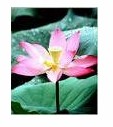 National
Flower: National
Flower:
Lotus (Nelumbo nucifera) is the National Flower of
India. It is a sacred flower and occupies a unique position
in the art and mythology of ancient India and has been
an auspicious symbol of Indian culture since time immemorial.
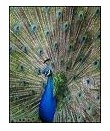 National
Bird: National
Bird:
The Indian peacock, Pavo cristatus (Linnaeus), the
national bird of India, is a colorful, swan-sized bird,
with a fan-shaped crest of feathers, a white patch under
the eye and a long, slender neck. The male of the species
is more colourful than the female, with a glistening
blue breast and neck and a spectacular bronze-green
train of around 200 elongated feathers. The female is
brownish, slightly smaller than the male, and lacks
the train. The elaborate courtship dance of the male,
fanning out the tail and preening its feathers, is a
gorgeous sight. The peacock is widely found in the Indian
sub-continent from the south and east of the Indus river,
Jammu and Kashmir, east Assam, south Mizoram and the
whole of the Indian peninsula. The Peacock enjoys protection
from the people as it is never molested for religious
and sentimental reasons. It is fully protected under
the Indian Wildlife (Protection) Act, 1972.
|
|

In a country as diverse and complex as India, it is
not surprising to find that people here reflect the
rich glories of the past, the culture, traditions and
values relative to geographic locations and the numerous
distinctive manners, habits and food that will always
remain truly Indian. According to five thousand years
of recorded history.
From the eternal snows of the Himalayas to the cultivated
peninsula of far South, from the deserts of the West
to the humid deltas of the East, from the dry heat and
cold of the Central Plateau to the cool forest foothills,
Indian lifestyles clearly glorify the geography. The
food, clothing and habits of an Indian differ in accordance
to the place of origin.
Indians believe in sharing happiness and sorrow. A
festival or a celebration is never constrained to a
family or a home. The whole community or neighbourhood
is involved in bringing liveliness to an occasion. A
lot of festivals like Diwali, Holi, Id, Christmas, Mahaveer
Jayanthi are all celebrated by sharing sweets and pleasantries
with family, neighbours and friends. An Indian wedding
is an occasion that calls for participation of the family
and friends. Similarly, neighbours and friends always
help out a family in times of need.
Ethnically Indians speak different languages, follow
different religions, eat the most diverse varieties
of food all of which add to the rich Indian culture.The
beauty of the Indian people lies in the spirit of tolerance,
give-and-take and a composition of cultures that can
be compared to a garden of flowers of various colours
and shades of which, while maintaining their own entity,
lend harmony and beauty to the garden - India!

India is a land of a variety of linguistic
communities, each of which share a common language and
culture. Though there could be fifteen principal languages
there are hundreds of thousands dialects that add to
the vividness of the country.
18 languages are officially recognized
in India of which Sanskrit and Tamil share a long history
of more than 5,000 and 3,000 years respectively. The
population of people speaking each language varies drastically.
For example Hindi has 250 million speakers, while Andamanese
is spoken by relatively fewer people.
Tribal or Aboriginal language speaking
population in India may be more than some of the European
languages. For instance Bhili and Santali both tribal
languages have more than 4 million speakers. The vividness
can be ascertained by the fact that schools in India
teach more than 50 different languages; there are Films
in 15 languages, Newspapers in 90 or more languages
and radio programmes in 71 languages!
Indian languages come from four distinct
families, which are: Indo-European, Dravidian, Mon-Khmer,
and Sino-Tibetan. Majority of Indian population uses
Indo-European and Dravidian languages. The language
families divide India geographically too.
Indo-European languages dominate the northern
and central India while in south India; mainly languages
of Dravidian origin are spoken. In eastern India languages
of Mon-Khmer group is popular. Sino Tibetan languages
are spoken in the northern Himalayas and close to Burmese
border. In terms of percentage, 75% of Indian population
speaks languages of Indo-European family, 23% speak
languages of Dravidian origin and about 2% of the population
speaks Mon-Khmer languages and Sino-Tibetan languages.

Nearly five thousand years back flourished
India's first major civilization along the Indus River
valley. The twin cities of Mohenjodaro and Harappa now
in Pakistan were ruled by priests and held the rudiments
of Hinduism. These civilizations are known to possess
a sophisticated lifestyle, a highly developed sense
of aesthetics, an astonishing knowledge of town planning
and an undecipherable script language. The Indus civilization
at one point of time extended nearly a million square
kilometers across the Indus river valley. It existed
at the same time as the ancient civilizations of Egypt
and Sumer but far outlasted them. Surviving for nearly
a thousand years the Indus valley civilization fell
to tectonic upheavals in about 1700 BC, which caused
a series of floods.
The coming of the Aryans around 1500 BC, gave the final
blow to the collapsing Indus Valley civilization. At
the dawn of Vedic ages the Aryans came in from the North
and spread through large parts of India bringing with
them their culture and religious beliefs. The Four Vedas
or the important books of Hinduism were compiled in
this period.
 In
567 B.C. the founder of the Buddhist Religion Gautama
Buddha was born. During this time lived Mahavira, who
founded the Jain Religion. The Indian subcontinent is
full of caves and monuments devoted to these religions
and are worth a visit. In
567 B.C. the founder of the Buddhist Religion Gautama
Buddha was born. During this time lived Mahavira, who
founded the Jain Religion. The Indian subcontinent is
full of caves and monuments devoted to these religions
and are worth a visit.
Two hundred years later, in the 4th century B.C., Emperor
Ashoka, one of the greatest King of Indian history,
led the Mauryan Empire to take over almost all of what
is now modern India. This great leader embraced Buddhism
and built the group of monuments at Sanchi (a UNESCO
world heritage site). The Ashoka pillar at Sarnath has
been adopted by India as its national emblem and the
Dharma Chakra on the Ashoka Pillar adorns the National
Flag.
They were followed by the Guptas in the north, while
in the south part of India several different Hindu empires,
the Cholas, the Pandyas and the Cheras spread and grew,
trading with Europe and other parts of Asia till the
end of the 1100s.
Christianity entered India at about the same time from
Europe. Legend has it that St. Thomas the Apostle arrived
in India in 52 A.D. Even earlier than that people of
the Jewish religion arrived on India's shores.
In approximately the 7th century A.D. a group of Zoroastrians,
or Parsees, landed in Gujarat and became a part of the
large mix of religions in India today, each of which
adds its important and distinctive flavour.
In the 15th century Guru Nanak laid the foundation of
the Sikh religion in Punjab.
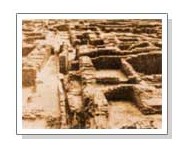 In
1192, Mohammed of Ghori, a ruler from Afghanistan, came
into India and captured several places in the north
including Delhi. When he went home he left one of his
generals in charge who became the first Sultan of Delhi.
During this time Islam, was introduced into a major
part of Northern India. It may be mentioned that even
before that, just after the period of the prophet, Islam
was brought to the western coast of India by Arab traders
and flourished in what is now Kerala. In
1192, Mohammed of Ghori, a ruler from Afghanistan, came
into India and captured several places in the north
including Delhi. When he went home he left one of his
generals in charge who became the first Sultan of Delhi.
During this time Islam, was introduced into a major
part of Northern India. It may be mentioned that even
before that, just after the period of the prophet, Islam
was brought to the western coast of India by Arab traders
and flourished in what is now Kerala.
The Dehli Sultanate gradually took control of more and
more of North India over the next 200 years, till Timur,
who was called "Timur the Lame" or "Tamberlane"
came from Turkey in 1398 to attack India. He and his
army stole all the valuables that they could carry and
left again, and after that the Delhi Sultanate was never
so strong again. Soon the Mughals, who were from Iran,
came in and took control of the north.
In the meantime south , in 1336, the Hindu Vijayanagar
empire was set up and became very strong.
The Europeans - Portuguese, French, Dutch, Danish and
British - started arriving in the early 1600s. All of
them held territories in India and made friends and
enemies among India's rulers as they got more and more
involved, with the Indian politics, but it was the British
who eventually controlled most of India and finally
made it one of their colonies.
India got its independence from Britain in 1947 after
a long struggle led mostly by Mahatma Gandhi. In the
process of becoming independent, India became, two countries
instead of one. In the years since independence India
has made huge progress and coped with great problems,
and has developed its industry and its agriculture,
and has maintained a system of government which makes
it the largest democracy in the world.

India is set apart from the rest of Asia
by the Himalayas, the highest, youngest and still evolving
mountain chain on the planet. The subcontinent as it
is rightly called, touches three large water bodies
and is immediately recognizable on any world map. This
thick, roughly triangular peninsula defines the Bay
of Bengal to the east, the Arabian sea to the west,
and the India Ocean to the south.
India holds virtually every kind of landscape imaginable.
An abundance of mountain ranges and national parks provide
ample opportunity for eco-tourism and trekking, and
its sheer size promises something for everyone. From
north to south India extends a good 2000 miles (3200
km), where the island nation of Sri Lanka seems to be
squeezed out of India like a great tear, the synapse
forming the Gulf of Mannar.
Himalayas, the world's highest mountain chain and Nepal
as its Neighbouring country dominate India's northern
border. Following the sweeping mountains to the northeast,
its borders narrow to a small channel that passes between
Nepal, Tibet, Bangladesh, and Bhutan, then spreads out
again to meet Burma in the "eastern triangle."
Apart from the Arabian Sea, its western border is defined
exclusively by Pakistan.
North India is the country's largest region begins
with Jammu and Kashmir, with terrain varying from arid
mountains in the far north to the lake country and forests
near Srinagar and Jammu. Moving south along the Indus
river, the North becomes flatter and more hospitable,
widening into the fertile plains of Punjab to the west
and the Himalayan foothills of Uttar Pradesh and the
Ganges river valley to the East. Cramped between these
two states is the capital city, Delhi.
The states of Gujarat, Maharashtra, Goa, and part of
the massive, central state of Madhya Pradesh constitute
West India. Extending from the Gujarat peninsula down
to Goa, the west coast is lined with some of India's
best beaches. The land along the coast is typically
lush with rainforests. The Western Ghats separate the
verdant coast from the Vindya Mountains and the dry
Deccan plateau further inland.
India is the home of the sacred River Ganges and the
majority of Himalayan foothills, East India begins with
the states of Madhya Pradesh, Bihar, Orissa, which comprise
the westernmost part of the region. East India also
contains an area known as the eastern triangle, which
is entirely distinct. This is the last gulp of land
that extends beyond Bangladesh, culminating in the Naga
Hills along the Burmese border.
India reaches its peninsular tip with South India,
which begins with the Deccan in the north and ends with
Cape Comorin. The states in South India are Karnataka,
Andhra Pradesh, Tamil Nadu, and Kerala, a favourite
leisure destination. The southeast coast, mirroring
the west, also rests snugly beneath a mountain range---the
Eastern Ghats.

The Colorful mosaic of Indian festivals
and fairs - as diverse as the land, is an eternal expression
of the spirit of celebration. Observed with enthusiasm
and gaiety, festivals are like gems ornamenting the
crown of Indian Culture. They are round the year vibrant
interludes in the mundane routine of life.
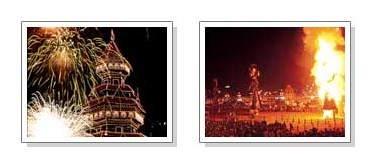 Every
season brings along new festivals, each a true celebration
of the bounties of the rich traditions followed for
time immemorial. That's not all! The birthdays of Gods
and Goddesses, saints and prophets, great historical
happenings and the advent of the New Year, all find
expression in colorful festivities. The same festival,
though celebrated differently in the various parts of
the country, exhibits an eternal harmony of the spirit
of celebration. Every
season brings along new festivals, each a true celebration
of the bounties of the rich traditions followed for
time immemorial. That's not all! The birthdays of Gods
and Goddesses, saints and prophets, great historical
happenings and the advent of the New Year, all find
expression in colorful festivities. The same festival,
though celebrated differently in the various parts of
the country, exhibits an eternal harmony of the spirit
of celebration.
Packed with fun and excitement, festivals serve as
an occasion to clean and decorate houses, to get together
with friends and relatives and to exchange gifts. New
attire, dance, music and rituals- all add to their joyful
rhythm. It is a time for prayer, for pageantry and procession卆
time to rejoice, in celebration of life.

The Indian cuisine boasts of an immense
variety not restricted to only curry. An authentic Indian
curry is an intricate combination of a stir-fried Masala
- a mixture of onion, garlic, ginger, and tomatoes;
various spices and seasonings with which meat; poultry,
vegetables or fish is prepared to produce a stew-type
dish. Note: the word Masala also means spice.
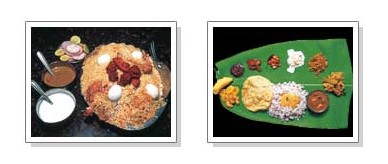 Food
in India is wide ranging in variety, taste and flavour.
Being so diverse geographically, each region has its
own cuisine and style of preparation. Indian cuisine,
renowned for its exotic gravies seems complicated for
any newcomer. The Mughlai cuisine of North differs sharply
from the preparations of the south. The Wazwan style
of Kashmir is luxurious but the same can be said about
Bengal's Macher Jhol, Rajasthan's Dal Bati, Uttar Pradesh's
Kebabs and Punjab's Sarson Ka Saag and Makki di Roti.
In India, recipes are handed down from generation to
generation. Food
in India is wide ranging in variety, taste and flavour.
Being so diverse geographically, each region has its
own cuisine and style of preparation. Indian cuisine,
renowned for its exotic gravies seems complicated for
any newcomer. The Mughlai cuisine of North differs sharply
from the preparations of the south. The Wazwan style
of Kashmir is luxurious but the same can be said about
Bengal's Macher Jhol, Rajasthan's Dal Bati, Uttar Pradesh's
Kebabs and Punjab's Sarson Ka Saag and Makki di Roti.
In India, recipes are handed down from generation to
generation.
The unique and strong flavours in Indian cuisine are
derived from spices, seasonings and nutritious ingredients
such as leafy vegetables, grains, fruits, and legumes.
Most of the spices used in Indian cooking were originally
chosen thousands of years ago for their medicinal qualities
and not for flavour. Many of them such as turmeric,
cloves and cardamoms are very antiseptic, others like
ginger, are carminative and good for the digestion.
All curries are made using a wide variety of spices.
In Indian cuisine, food is categorized into six tastes
- sweet, sour, salty, spicy, bitter and astringent.
A well-balanced Indian meal contains all six tastes,
not always can this be accomplished. This principle
explains the use of numerous spice combinations and
depth of flavour in Indian recipes. Side dishes and
condiments like chutneys, curries, daals and Indian
pickles contribute to and add to the overall flavour
and texture of a meal and provide balance needed.

The Indian telecommunications Network
is the fifth largest in the world and is the second
largest among the emerging economies of Asia.
Today it is the fastest growing market in the world.
Private operators have made mobile telephony the fastest
growing (over 164% p.a.) in India.
With more than 33 million users (both CDMA and GSM),
wireless is the principal growth engine of the Indian
telecom industry. Intense competition between the four
main private groups - Bharti, Hutch, Tata and Reliance
and with the State sector incumbents-BSNL and MTNL has
brought about a significant drop in tariffs.
The Government has played a key enabling role by deregulating
and liberalizing the industry, ushering in competition
and paving the way for growth.
Art
& Culture
Classical Dance and Music
Indian Classical Dance ".Abstraction of Upanishad
thought which is assiduously translated in to well designed
concrete language of artistic media."
It all started with Natya Shastra
Said to be written 2000 years ago by Bharata Muni, it
is the seminal source book for dancers and performers.
The mammoth book covers all technical and aesthetic
aspects of the art of the Indian Theatre and Dance.
From the purpose of natya, to the architectural format,
stage rituals, Rasa, Bhava, Abhinaya, gestic communication,
music, types of instruments. 37 chapters that together
form the nucleus of this fascinating performing art.
Later century works like Abhinaya Darpana, Abhinaya
Chandrike, also have great relevance to the dancer today.
Legend has it that the Devas (Gods) had vanquished
the Asuras (Evil) and were relating the happenings to
Brahma, the God of Creation. The Asuras thought this
was a renewed attack and retaliated. Brahma intervened
- "This is only a performance, hence forth it will
only be held on earth".
And Brahma passed on all the information on Dance and
Drama to Bharata Muni who compiled it as the Natya Shastra.
Sculpture Comes To Life
Temples were raised to the house the Gods and became
the focal point for the community. They also became
centres of learning and contributed to the advancement
of such arts as sculpture, painting, music and dance.
Mostly built by Kings, who were also the patrons of
arts, encouraging continuity and enriching rituals of
worship, the earliest basis of the classical performing
arts.
It was from the temple that the Devdasi cult (Temple
Dancers who performed for the Lord) began. Once a practice
countrywide - the Kulvantalu in Andhra Pradesh, the
Maibi in Manipur, the Devdasi in Tamil Nadu and the
Mahari in Orissa, all trace their roots to the temple.
The countless sculptures of dance poses in the temples,
hint at the potency of dance as a path to spiritual
exaltation and lays out a complete lexicon of dance
techniques.
For instance, it is said that the greater part of vocabulary
of Odissi dance is preserved in stone.
A rich heritage to be brought alive by the artist.
Classical Dance
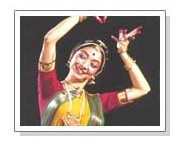 Bharat
Natyam, one of the oldest Indian Classical dance forms
is an essence of dedicatory dance. This was performed
by Devadasis in the temples, primarily in Tamil Nadu
and to lesser extent in Andhra Pradesh and Karnataka. Bharat
Natyam, one of the oldest Indian Classical dance forms
is an essence of dedicatory dance. This was performed
by Devadasis in the temples, primarily in Tamil Nadu
and to lesser extent in Andhra Pradesh and Karnataka.
Bharat Natyam is compounded from 'bha' for bhava or
emotional projection, 'ra' for raga or melody and 'ta'
for tala rhythm. Natyam means the art of dance.
The Sangam Age from 500 B.C to 500 AD marks the evolution
of this dance form. The early part of the present century
saw the resurgence of this dance form.
The key posture of this dance form requires the upper
part of the body to be erect, the legs bent halfway
down with the knees spread out, and the feet positioned
like a half open fan. Practically every part of the
body has its distinct movement.
The songs used are composed from the poetic literature
of Tamil, Telegu, and Sanskrit and to some extent Kannada.
The accompanying music is in pure Carnatic style.
Today, Bharat Natyam is not a dance style but a dance
technique.
KUCHIPUDI
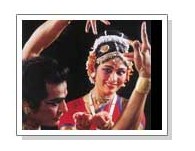 The
art form takes its name from the village of its birth,
in the Krishna district of Andhra Pradesh. Kuchipudi
was the result of the Bhakti Movement in the 6th Century,
Siddendra Yogi, the progenitor of the form, presented
a dance drama with boys from the village of Kuchipudi.
Consciously they raised the form above the reach of
Devdasi. The boys were committed to an annual presentation
of the form and they passed on the techniques to the
next generation. So a tradition and a form were born. The
art form takes its name from the village of its birth,
in the Krishna district of Andhra Pradesh. Kuchipudi
was the result of the Bhakti Movement in the 6th Century,
Siddendra Yogi, the progenitor of the form, presented
a dance drama with boys from the village of Kuchipudi.
Consciously they raised the form above the reach of
Devdasi. The boys were committed to an annual presentation
of the form and they passed on the techniques to the
next generation. So a tradition and a form were born.
The performer has to express through the language of
gestures, speech and song. The Kuchipudi artiste, apart
from being a dancer and an actor has to have a high
proficiency - in Sanskrit and Telegu languages, music
and the texts of performance.
Kuchipudi plays are performed in the open air on improvised
stages at night. The sutradhar, or master of ceremonies
plays an integral role introducing characters, providing
humour and tying together the show. The fast paced nature
of the form has made it a popular dramatic form.
It is better known as a solo form today but the wheel
has come full circle with group work, with experimental
choreography much in demand.
MOHINI ATTAM
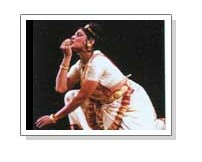 Mohini
Attam is one of the youngest Indian Classical dances.
This form of dance came into its own by the 16th Century
and was evolved under the patronage of Maharaja Swati
Thirunal of Travancore (present day south Kerala). Mohini
Attam is one of the youngest Indian Classical dances.
This form of dance came into its own by the 16th Century
and was evolved under the patronage of Maharaja Swati
Thirunal of Travancore (present day south Kerala).
Mohini means a maiden who excites desire and her dance
is known as Mohini Attam. From the inception itself,
Mohini Attam was conceived as a form of social diversion.
The themes of the songs were both religious and social.
In the matter of technical format, there are many similarities
between Mohini Attam and Bharat Natyam and also the
central motif of adavus (gestures) being the same. It
is essentially a solo dance and performed by women with
tender and graceful body movements belonging to the
lasya style. The hand gestures play an important part
as a communication medium.
The costume comprises a white sari with gold ornaments
on the neck, waist, wrists and a typical hair bun with
flowers on the left side of the head.
The dominant emotion in Mohini Attam is of shringara
(love).
KATHAKALI
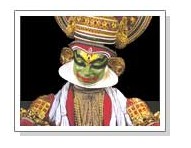 Kerala
presents to the country one of the most imposing and
colourful spectacles of dance Kathakali. It is heroic,
majestic and epic in character. Kerala
presents to the country one of the most imposing and
colourful spectacles of dance Kathakali. It is heroic,
majestic and epic in character.
Though this form of art is not more than 300 years old,
the actual roots can be traced to 1500 years earlier.
It symbolises the blending of the Aryan and Dravidian
cultures and is presumed to have evolved out of the
various ancient theatre traditions of the region like
Krishnattam, Ramanattam, Koodiyattam, Mudiyyetu and
Teyyam. Mahakavi Vallathol of Cherutoorthi (Palakkad)
contributed greatly in the revival of this art by forming
Kalamandalam, the famous teaching institution, set up
in the thirties.
Mostly based on the mythology and the themes of Ramayana
and Mahabharata, a Kathakali performance opens with
the thunder of drums, which invites the audiences. The
performance lasts night long and till recently only
men were allowed to perform even in female roles. Nowadays,
though, many women have made their mark in this art
form
As a form of art, Kathakali is a sophisticated spectacle
of the supernatural.
ODISSI
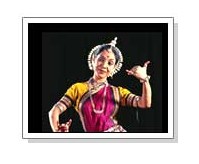 A
dance form born in the state of Orissa, manifested in
temple sculptures from 2nd century BC, practiced and
enriched by the Devadasis or maharis (as the temple
dancing girls are called in Orissa). With the construction
of the Jagannath Temple in Puri in the 12th century,
the practice of dedicating maharis in the service of
the temple was initiated and continues to this day. A
dance form born in the state of Orissa, manifested in
temple sculptures from 2nd century BC, practiced and
enriched by the Devadasis or maharis (as the temple
dancing girls are called in Orissa). With the construction
of the Jagannath Temple in Puri in the 12th century,
the practice of dedicating maharis in the service of
the temple was initiated and continues to this day.
At once sensuous and spiritual, it has the ability to
portray erotic sentiments in a deeply reverential manner.
Odissi is a highly stylised dance with tribhanga or
the three-bend attitude of Hindu sculpture. The bhava
or feeling is chaste and orthodox, with flashes of heightened
dramatization.
The accompanying music is pure and classical, with graces
of both the Hindustani and the Carnatic styles. The
instruments traditionally used are the mandala-drums,
gini-small cymbals and the flute.
Odissi has been restored to its rightful place only
in the last few decades with the tireless work of Gurus
like Pankaj Charan and Deba Prasad Das, Kelucharan Mohapatra
and Mayadhar Raut .
MANIPURI
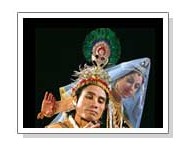 The
Manipuris have song and dance woven in to their lives
and regard themselves as the descendents of the Gandharvas.
Their love for dance reflects their rich lore of legend
and mythology. The
Manipuris have song and dance woven in to their lives
and regard themselves as the descendents of the Gandharvas.
Their love for dance reflects their rich lore of legend
and mythology.
There is no authoritative record of the history of Manipur's
dance and music prior to the 18th Century AD.
However the lasting developments in technique and methods
took place during the time of Jai Singh (1764-1789),
who was a great devotee of Lord Krishna and a follower
of Vaishnavism.
Among the legendary and mythological tales, the Rasa
Lila, dance performed by Shiva and Parvati and Lai Haraoba
of Khamba and Thoibi the celebrated lovers, deserves
special mention.
In the Ras Lila, the movements are extremely graceful
coupled with soft and light steps in which the heels
never touch down. The dancers have a fixed angelic expression
on their face. The costume is extremely colourful and
glittering.
Lai Haraoba is the oldest dance form of Manipur and
belongs to the pre Vaishnava period. The dance style
is diffused and meandering. The dancers make stylised
hand and body movements, but the face remains blank.
The steps are gentle yet powerful.
Even today dancing remains a key element in the art
and daily ritual of Manipur.
KATHAK
 Kathaks
were originally story tellers who used to dance to illustrate
'Kathas' or stories. They were attached to the temples
of North India. Kathaks
were originally story tellers who used to dance to illustrate
'Kathas' or stories. They were attached to the temples
of North India.
With the advent of Muslim rule, Kathak went from the
temple to the courts. Consequently Kathak flowered as
a form in the Hindu courts of Rajasthan and the Muslims
courts of Delhi, Agra and Lucknow. Court patronage evolved
Kathak into a highly technical and stylished art with
emphasis on the solo performers and their virtuosity.
Gradually, the two schools became distinctively different
the Jaipur Gharana focussed on layakari, or rhythmic
wizardly, while the Lucknow Gharana expounded bhava
or moods and emotions. Nawab Wajid Ali Shah was instrumental
in the Lucknow Gharana's growth, ( Satyajit Ray's film
Shatranj Ke Khilari, deals with the period). However,
both schools have Radha & Krishna as their central
theme.
Rhythm, timing and so footwork are the main planks of
Kathak. The musical accompaniment to the 200 ghungrus
or bells on the dancer's feet, are the sarangi and the
tabla.
Kathak is a true fusion of the Hindu and Muslim genius
in art and it the only Classical dance of North India.
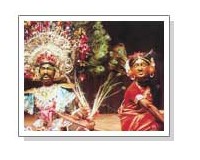 CHHAU CHHAU
The etymoligal root of the word Chhau is traced to
the Sanskrit Chhaya or shade, referring to the mask
used by the dancers. Others aver, it is derived from
the word 'Chauuni' where the pharikhanda (shield &
sword) soldiers stayed.
The technique of the dance, infact, draws on steps
and gait which have stemmed from the 'Pharikhanda System'.
It is basically a martial dance where the mask holds
the dominant Rasa while the body creates, projects,
and develops the moods.
Chhau has three schools as such, coming from Seraikella
in Bihar, Mayurbhanj in Orissa and Purulia in West Bengal.
While all the three Chhau forms are danced by men, Mayurbhanj
uses no masks but the others do.
The themes are based on mythology, everyday life, aspects
of nature or just a mood or emotion. Purulia Chhau,
however, has a single focus - good triumphs over evil.
The music is based on Hindustani Ragas and the Accompaniment
is with a Nagara, a huge kettledrum, Dhol, a cylindrical
drum, and Shehnai or reed pipes.
The strenuous nature of the dance restricts performances
to brief periods, but in Purulia Chhau a single item
could be a forty minutes and a performance, night long.
Indian Folk and Tribal Dances
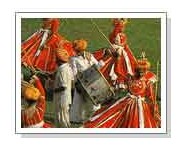 Indian
folk and tribal dances are simple , and performed to
express joy. Folk dances are performed for every possible
occasion, to celebrate the arrival of seasons, birth
of a child, a wedding and festivals. The dances are
extremely simple with minimum of steps or movements.
The dances burst with verve and vitality. Men and women
perform some dances exclusively, while in some performances
men and women dance together. On most occasions, the
dancers sing themselves, while being accompanied by
artists on the instruments. Each form of dance has a
specific costume. Most costumes are flamboyant with
extensive jewels. Indian
folk and tribal dances are simple , and performed to
express joy. Folk dances are performed for every possible
occasion, to celebrate the arrival of seasons, birth
of a child, a wedding and festivals. The dances are
extremely simple with minimum of steps or movements.
The dances burst with verve and vitality. Men and women
perform some dances exclusively, while in some performances
men and women dance together. On most occasions, the
dancers sing themselves, while being accompanied by
artists on the instruments. Each form of dance has a
specific costume. Most costumes are flamboyant with
extensive jewels.
The northeast part of the country is the home for over
60 tribes. Each tribe has its own range of tribal dances.
The exciting dances of the Nagas and the Bihus of Assam,
are performed to celebrate spring and harvesting.
The chief folk dance of Gujarat, the Dandiya, is performed
using sticks. Each performer holds two sticks, which
they strike alternately to the right and left while
the group dances. They also move diagonally, clockwise,
anti-clockwise, as they strike the sticks.
The Bhangra dance of Punjab is performed by men, to
the rhythm of the drum. The dance includes a wide range
of leaps and jumps. Dancers stand on each other's shoulder
while dancing to the music.
There are hundreds of Indian folk and tribal dances.
Each region of India has its own folk dance. Both men
and women perform the bamboo dance of Mizoram. While
the men hold the bamboo, the women folk dance between
the bamboo. In this performance, the sound of the bamboo
hitting each other is the rhythm. Though dangerous if
a rhythm is missed, these experienced dancers perform
with grace and with care.
In the south, the dummy horse dance or the Poikalkuthirai,
is very famous. Dancers fit dummy legs to their legs
and dance to the tune of the music. Both men and women
perform this form of art. In Tamil Nadu, dancers place
a karagam or a decorated jug, on their head and dance
while balancing the karagam.
While there are numerous folk and tribal dances, they
are constantly improved. The skill and the imagination
of the dances influence the performance.
|



